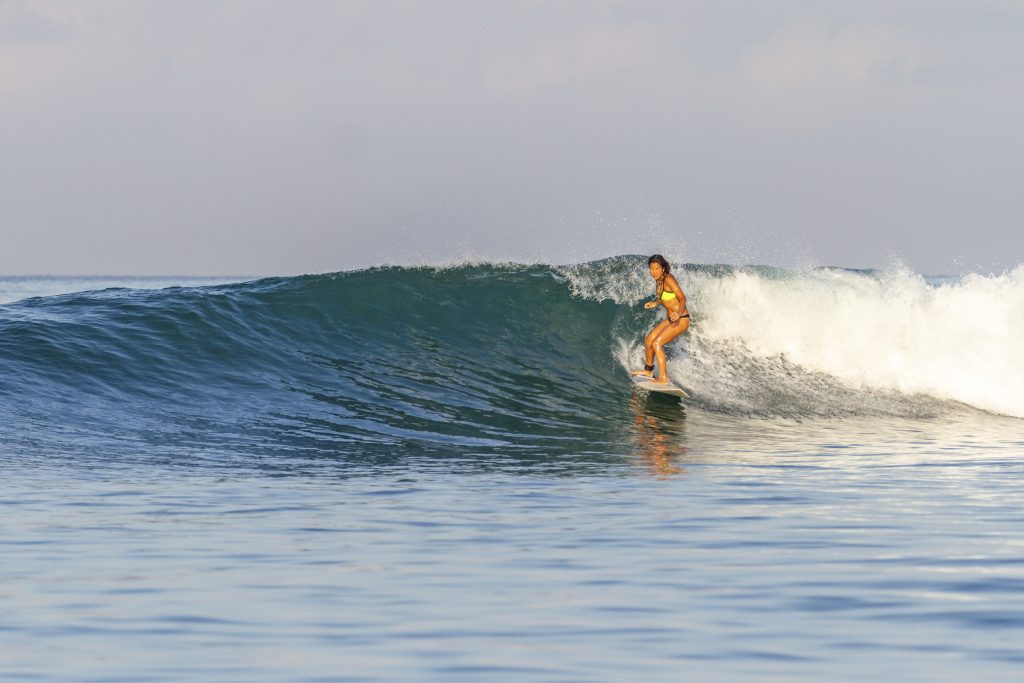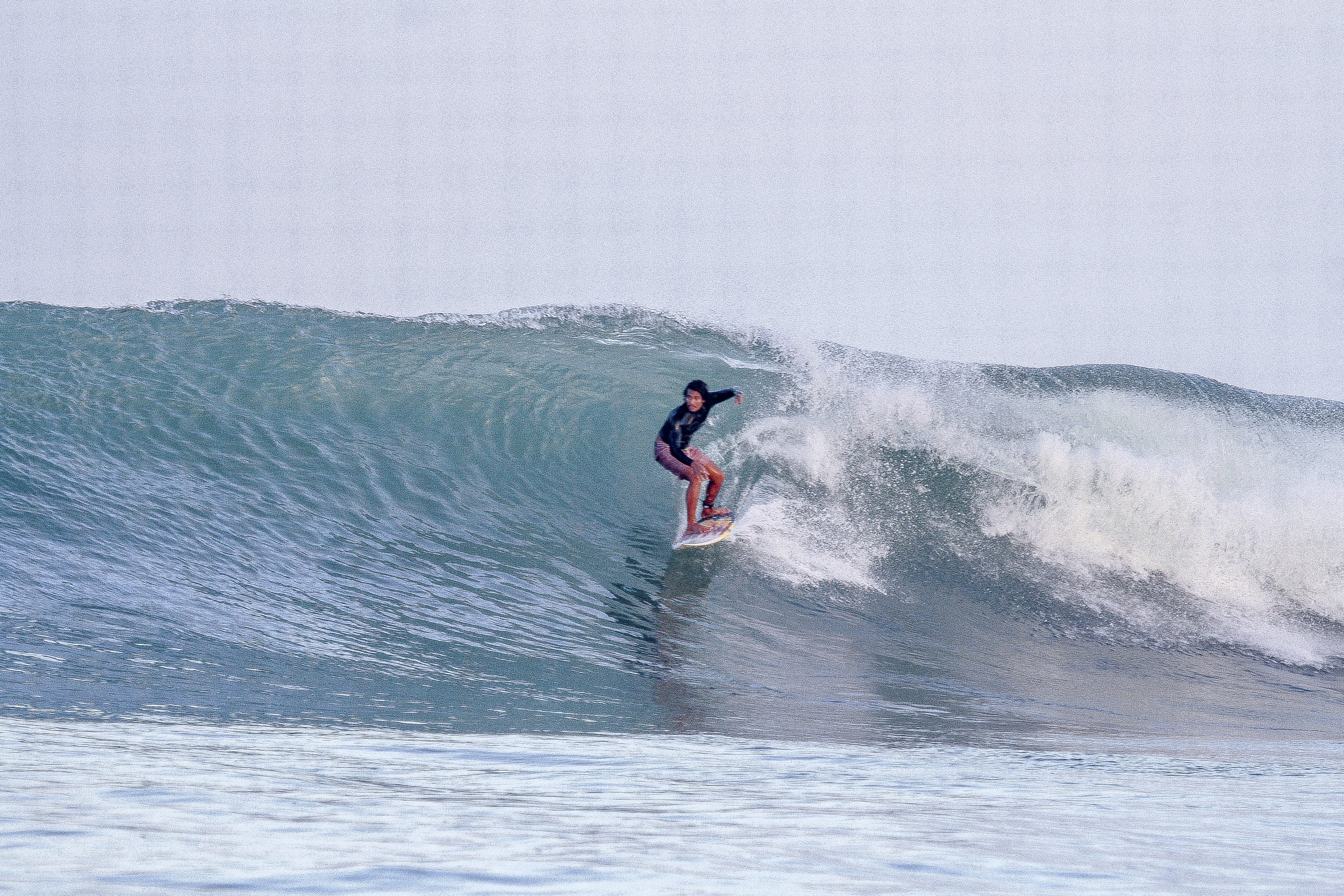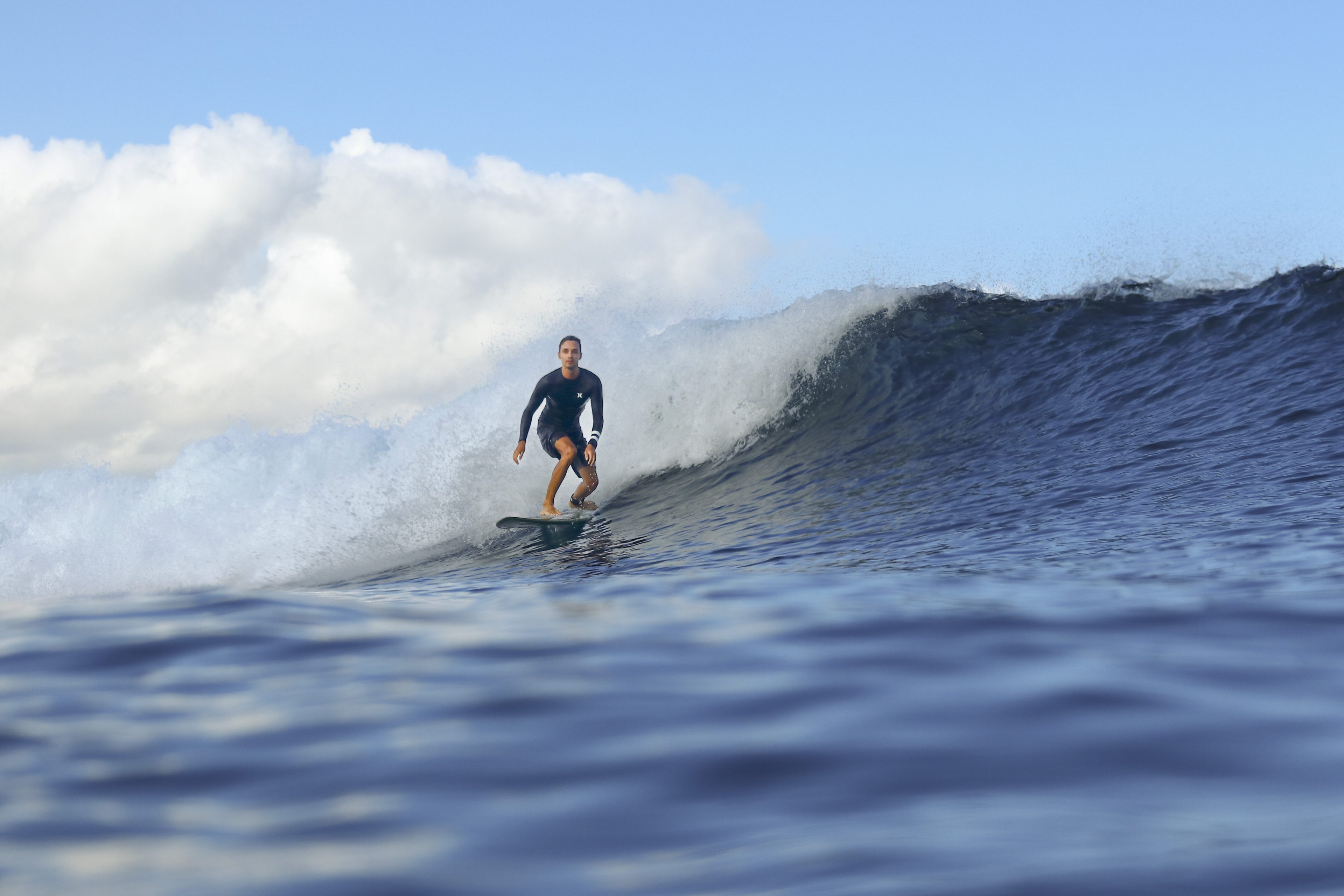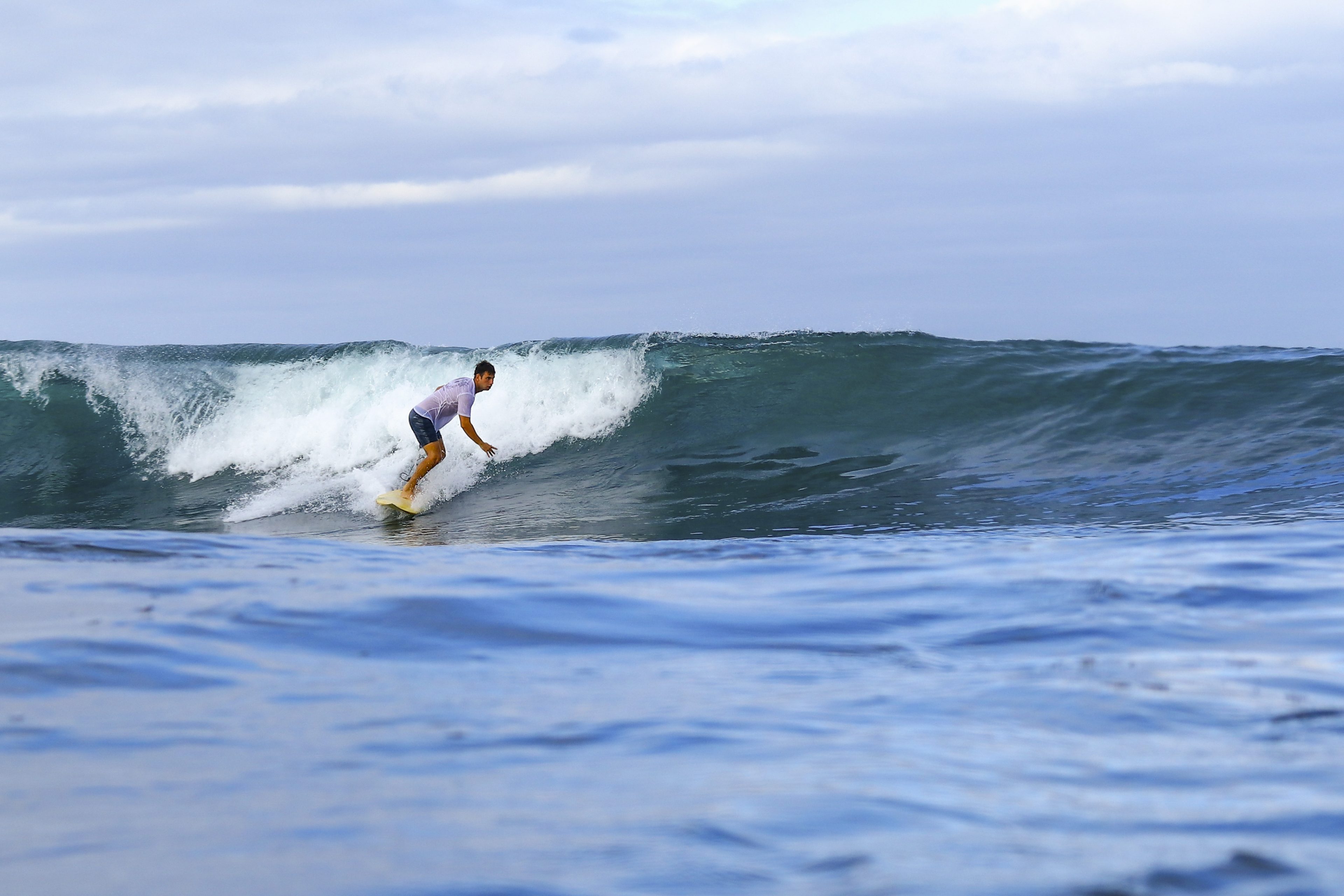
The Complete Guide to Surfing Bali’s Airport Reefs
The Airport Reefs are located near to the end of the runway of Bali’s Ngurah Rai International Airport, on both the Kuta side and in Jimbaran Bay.
Here you’ll find the Airport Reefs: five world-class outer reefs easily accessible by boat. What could be more fun than taking a traditional boat to surf an outer reef?
The Airport Reefs are paddling distance from the beach. It’s tiring to paddle such a long distance to surf for a couple of hours and then paddle back. We recommend you take a boat because it’s a lot more fun, and you will be fresh at the start of your surf session.
Getting the boat to the Airport Reefs is a must-do for any surfer visiting Bali. It’s often a highlight of a surfer’s trip to Bali.
All of the Airport Reefs are suitable for intermediate and advanced surfers. Read on to learn more about Bali’s 5 world-class outer reefs.
Airport Reefs surf spot information
Toro Toro
Toro Toro gets its name because it’s very popular with Japanese surfers that take the boat from Kuta.
Toro Toro is an easy wave and is number 1 on our list of the best intermediate surf spots in Bali.
It has a single peak that breaks both left and right.
The right-hand wave can be a very long ride and it’s great for practicing cutbacks. So Toro Toro is great for regular foot surfers that want to surf front-hand and are looking for a change from the left breaking waves of Bali.

The left-hander at Toro Toro is usually a very short ride into the channel. On a medium sized swell at high tide it can barrel, and what it lacks in length of ride, it makes up for intensity. Be careful on the left as it breaks into very shallow water. On the very biggest swells the left hander comes alive and is a great wave at low tide. The right hand wave often closes out on the biggest days, and the peak shifts away from the airport runway. The left never closes out and the bigger the swell, the longer the ride.
You’ll want to surf Toro Toro at mid-tide on a large swell because that’s when it’s best. But Toro Toro can also be fun at low tide on a medium swell. At high tide, the wave fattens out and will only break on the biggest of swells.
Toro Toro attracts intermediate surfers and Japanese longboarders due to its predictive and soft-breaking nature.
Toro Toro is located in Jimbaran Bay and protected from the prevailing swell direction. It can be a good option when other spots in Bali are too big. It is one of the easiest waves in the world to surf as it breaks slowly and softly in the same spot.
Toro Toro inside
If Toro Toro is too big to hold the swell size, or for your ability, then at mid to high tide there is a inside wave located about 200 metres closer to the shore than the main peak. This is a great wave for intermediates and under rated. On the very biggest days this is a top quality wave and arguably the easiest wave in the world to get a great ride, as you can take off in the whitewater and wait for it to reform to a swell wave. It breaks left and right and on its day is as much fun as the main Toro Toro peak.
Tower
Located mid-way between the shoreline and Toro Toro is another inside wave, that is perfect for novice surfers at high tide on a big swell. It is always smaller than Toro Toro inside and breaks gently left and right. It is easier to take the boat to access the wave but is not too far from the beach to paddle out.

Airport Rights
Airport Rights is located very close to the end of the airport runway and about 300 meters from Toro Toro.
This is one of Kelly Slater’s favorite spots when he is in Bali. If you’re lucky, you might just catch Slater out in the lineup.
Airport Rights is always one foot bigger than Toro Toro as it’s more exposed to the swell.
You’ll want to surf Airport Rights on a high tide because it gets dangerously shallow at mid-tide and is a definite no-go at low tide.
Airport Rights only breaks right, and it’s a long fast hollow wave.
On very big swells, Airport Rights is only for expert surfers due to the strong rip and power of the wave.
At head high and at high tide, Airport Rights is suitable for intermediates. But usually, Toro Toro is the better option for intermediates because it breaks slower and softer.
Airport Rights is one of the best waves in Bali for advanced surfers.
Additionally, due to the difficulty of the access to Airport Rights (you must take a boat to get here), you can score it uncrowded.

Airport Lefts
Airport Lefts is located on the other side of the runway from Airport Rights, near Tuban, Kuta. As the name suggests, Airport Lefts breaks to the left.
Airport Lefts is more exposed to the swell than the Jimbaran reefs and it’s usually one foot bigger than Airport Rights. So if Toro Toro and Airport Rights are too small, then you can take a 5-minute boat ride past the airport runway here.
Airport Lefts is never flat. But it has a shifty peak. And it can be quite difficult to surf on a big swell due to the shifting nature of the peak.
Airport Lefts is a soft-breaking wave, the rides are quite long, and the channel offers an easy paddle back.
On bigger days, you run a high risk of getting caught by a set wave unless you stay close to the channel where the boats are parked. The bigger the sets, the closer you need to be to the boats not to get caught inside. If you take off too deep and don’t make the wave, or get caught inside you will get punished but fortunately the wave does not break very heavily.
This is a great spot for surf photos because the boat can safely park close and in a good position to get an excellent view of the action.
In 2019, the airport ground was extended closer to the surf break. This did not directly affect the surfing reef (the wave is still the same) but it did improve protection from the trade winds.
All of the Airport Reefs in Bali can get easily blown out by the south-easterly winds that usually kick in mid-morning, except for Airport Lefts.
Airport Lefts is best surfed at mid-tide. But it also works well at high-tide on a bigger swell. At low tide, the reef is too exposed and the boats are unable to access the break.
Airport Lefts is a great intermediate surf spot when it’s around head high due to the length of ride, soft-breaking nature, and accessibility of the channel.

Middle Reef
Middle Reef is named as such because it’s in the middle between Airport Lefts and Kuta Reef (read on to learn about Kuta Reef).
Middle Reef is a low tide break and it picks up the most swell of all the Airport Reefs. It will still break good at mid tide on bigger days.
The peak at Middle Reef is not as shifty when compared to Airport Lefts.
Middle Reef is a high-quality wave and it’s popular with expat surfers.
On a dead low tide the paddle from the beach is not very far and you can avoid the expense of taking a boat.

Kuta Reef
The 5th and final airport surf spot is Kuta Reef.
Kuta Reef breaks closer to the shore than Airport Lefts and Middle Reef and breaks left.
It also picks up less swell compared to the other 2 reefs located on the Kuta side of the airport.
But Kuta Reef is the highest quality wave due to its predictive nature and length of ride. It’s best surfed at mid-tide and throws the occasional soft-barrel. On the biggest swells Kuta reef is excellent at high tide and is one of the best waves in the world for intermediate-advanced surfers.
Kuta Reef has a difficult take off if the tide is low, but gets much more fogiving as the tide fills in and becomes a truly perfect wave. But this means it can get very crowded with local surfers and tourists all searching for that easy barrel and long ride. On the bigger days the wave gets better and less crowded.
Kuta Reef Inside
When the swell is very big or the tide is a bit low then the inside wave is a good option as it is smaller with an easier take off. This is great wave for intermediate surfers and also breaks left.

When is the best time to surf Bali’s Airport Reefs?
The best time to surf Bali’s Airport Reefs is early morning during the dry season (April to October).
July and August are not the best months because the trade winds are very strong and are sometimes blowing hard, even at first light.
Due to the Airport Reefs’ distance from the shore, even a medium strength offshore wind can make the surf choppy and difficult to ride. An offshore wind is generally ideal for surfing, but if the fetch is too far i.e. the distance the wind is blowing over the water, then an offhore wind can be even worse than onshore.
Unlike the surf spots in the Uluwatu region of Bali that are protected by high cliffs, the Airport Reefs are very exposed to all wind directions.
The exception to the winds is Airport Lefts because the airport runway offers some protection from the cross-offshore winds that are predominant in the dry season.
In the wet season, the swell is often too small for most of the Airport Reefs. And the southwest and west winds will chop up the water.
The main problem with the Airport Reefs is that a medium-strength wind from any direction will negatively affect the wave quality.
Usually, April and October are the best months for surfing Airport Reefs because the wind is generally very light when the seasons transition between wet and dry in April and October.
You’ll get many days every month in the dry season where the conditions are good at Airport Reefs.

Can beginners surf Airport reefs?
None of the Airport Reefs can be classified as beginner waves. The distance from shore and the coral reef bottom are two reasons why they are not ideal for beginners. However, on a big swell Tower is suitable for L2 surfers i.e. novice but not complete beginners.
Can intermediates surf Airport reefs?
Toro Toro and Airport lefts are good for intermediate surfers on a small swell. Toro Toro is one of the easiest waves in the world as it breaks slowly in the same place. Airport lefts is shifty but it is soft-breaking and the ride fizzles out in a deep water channel.
Airport rights and Middle reef are only suitable for advanced surfers due to the difficulty of the take off. Kuta reef has a very difficult take off at mid-tide but is much easier at high tide.
How to enter the surf at Airport reefs
It is best to take a boat due to the distance from the shore. The boat will drop you in a deep-water channel, and it is a short, easy paddle to any of the Airport Reefs. It’s best to take a boat from Jimbaran Bay if surfing Toro Toro or Airport Rights. If these breaks are too small it is usually additional cost to motor past the airport runway to Airport lefts or Middle reef.
If you are staying Kuta side of the airport, then best to take a boat from Pantai Jerman. It’s also possible to take a boat from Pantai Melisan – this is the closest place to access airport lefts.
How to exit the surf at Airport reefs
At the end of your last wave, look for your boat, if you booked the boat to stay for the duration of the session. It can be hard to identify which is your boat as they all look the same. Colour is the best way to distinguish. If you booked a shuttle boat this is a little bit more complicated as could be a different boat picking you up. Confusing? Yes. Particularly if the boat driver does not speak English. We would recommend going with a local surf guide, who can help you book the boat, decide which reef to surf depending on swell size and your ability, help you in the line up and at the end of the session, help you find your boat!
Where to stay
That very much depends on if you plan to surf the Jimbaran Bay side or the Kuta side of the airport. There are some great 5 star chain hotels located on the beach at Jimbaran Bay, but you would still need to drive to get to the spot where the boats operate. We would not recommend staying within walking distance of the boat operators as the smell from the fish market is overwhelming. There are many budget accommodation options on Jalan Uluwatu but it is a little bit far to walk to the beach
On the Kuta side the airport, the Patri Bali resort is walking distance from the the beach that is closest to Airport Lefts. Bintang Bali resort is located immediately behind the other boat location. Bintang Bali is a faded 5 star hotel but great value for money. If you are looking for something more modern nearby then we can recommend Bali Dynasty Resort and Discovery Kartika Plaza. On Jalan Kartika Plaza there are many mid-priced and budget accommodation options.
Where to eat
Jimbaran Bay is famous for their Seafood restaurants on the beach. Lobster, Crab, Clams, Squid, Prawns, Fish all fresh from the market and reasonably priced. Cuca is an excellent Tapas restaurant which is more expensive that the Seafood restaurants but well worth the money for such high quality of flavours.
The choice of restaurants in Kuta, Legian and Seminyak is incredible. With so much competition they must be good to stay in business. If you are looking for high end dining then Sarong has got a wow factor with Indonesian, Thai and Indian food to choose from, you will not be disappointed.
What to do for non-surfers at Airport Reefs
The trip in the boat is an experience in itself. Sit in the channel and watch the surfers and take photos. Another option is to go fishing a little bit more offshore.
Conclusion
Bali’s Airport Reefs offer a variety of high-quality waves that break both left and right. Depending on the conditions, they can be perfect for intermediate, advanced, and expert surfers.
Toro Toro is one of the easiest and most fun waves in the world. And its big brother Airport Rights is one of the most serious high-performance barrelling waves on the planet.
Kuta Reef is world-class. Middles is a reliable swell magnet. And Airport Lefts is perfect for intermediates when Toro Toro is too small, and has the advantage of being protected from the trade winds.
Something everyone must experience in life is a boat trip out to the Airport Reefs. We at Padang Padang Surf Camp have shared the joy of Bali’s Airport Reefs with countless surfers.
So join our surf camp or enroll in our surf school today and we’ll take you to the best surf spot in Bali on any given day, including Airport Reefs.
We’ll see you on the fun boat!
